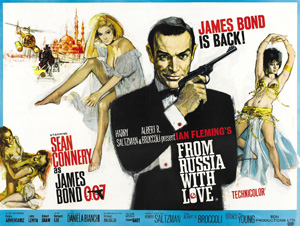So, Bond is back.
He is
indeed. The first film was such a success that there had to be a sequel, and
there were plenty of Ian Fleming novels waiting to be adapted.
Why this one?
Well,
President Kennedy had named the book as one of his ten favourite novels of all
time in a 1961 issue of Life magazine.
The book is also one of Fleming’s most compelling thrillers, with a really
strong plot.
Is the film faithful to the book?
Mostly, with
a few adjustments. For example, in the novel the Russians were the antagonists,
whereas in the film Bond is up against SPECTRE, the evil organisation introduced
in Dr No.
So what’s the story?
MI6 is
contacted by Tatiana Romanova, a Russian cipher clerk who claims that she has
fallen in love with a file photo of Bond and wants to defect, promising to hand
over a cryptographic device called the Lektor in exchange for safe passage to
England. Bond and M assume that this is an elaborate trap set by Russian
intelligence, but it is in fact the work of SPECTRE, who have recruited Colonel
Rosa Klebb as a Soviet mole.
Despite recognising
the ruse, the chance of obtaining the Lektor is too great to pass up, and Bond
is dispatched to Istanbul to escort Romanova back to England. Meanwhile, SPECTRE
assassin Donald Grant secretly works to protect Bond’s life until he has possession
of the Lektor, after which Grant intends to murder Bond (in retaliation for the
death of Doctor No) and steal the device for his employers.
That’s quite intricate.
Yes, but the
plot is really just an excuse for us to enter Bond’s crazy world of excitement and intrigue.
Who’s back from the last film?
Sean Connery
is back as Bond, looking just as assured and comfortable as he did the first
time round. If I had been alive to see From
Russia With Love in 1963, I think I would have had a hard time imagining
anyone else in the role. Also back are Bernard Lee as M and Lois Maxwell as
Moneypenny, and we also get the first appearance of Desmond Llewellyn as Q, the
legendary gadget-master.
Ooh, so does Bond get some gadgets
this time?
He gets an attaché
case, which contains a hidden knife and releases tear gas if not opened in a
particular way. Actually, it’s the villains who get the most interesting gadgets;
Grant has a garrotte wire that extends out of his wristwatch, and two of the
SPECTRE agents – including Rosa Klebb – wear deadly shoes fitted with a venom coated
blade. It makes sense that the villains are better equipped than Bond, since it
gives him more obstacles to overcome.
Any supporting players of note?
There’s the
totally charming Pedro Armendariz as Kerim Bey, Head of MI6 Station T and Bond’s
contact in Istanbul. Kerim is a great character because you really believe that
he and Bond are friends, thanks to the fantastic chemistry between Armendariz
and Sean Connery. Sadly, Armandariz was suffering from terminal cancer during
filming, and died before the film’s release. Also, Daniela Bianchi is really
good as Tatiana, coming across as very genuine and sincere.
Are the villains as good as Doctor
No?
Yes. This
time we actually have a trio of villains: Red Grant, Rosa Klebb, and SPECTRE
chief Ernst Stavro Blofeld, who at this point is a hand stroking a white cat.
Lotte Lenya delivers a very effective performance as Klebb, but both she and
Blofeld remain in the background for the majority of the film. Bond’s main
adversary in From Russia With Love is
Grant - a coldly efficient killing machine trained for the specific purpose of assassinating
James Bond - played by the excellent Robert Shaw.
Henchmen in
Bond films are often expected to have a gimmick of sorts, but Grant doesn’t need
one; he is just a truly frightening man, casually disposing of anyone who
threatens Bond’s life while relishing the prospect of murdering Bond himself. One
of my favourite sequences comes in the last third of the film, when Grant masquerades
as ‘Captain Nash’, a British agent sent to rendezvous with Bond. Grant’s
attempts to come across as a jovial Englishman are painfully forced, and Bond’s
suspicions gradually mount until Grant drops the pretence and reverts back to
his natural state. It’s incredibly effective and somewhat chilling, even better
for taking place aboard the Orient Express.
Are the production values still as
high this time around?
Yes, the
same level of care that was put into Dr
No is applied here, with the same results. There appears to be a little
less studio filming than there was last time, but the sets and lighting still
look incredibly lavish, and the direction remains well-judged.
The title sequence
is also noticeably more ambitious, and this time the credits are projected onto
the bodies of belly dancers.
That’s a point: is there a theme song?
Yes: From Russia With Love, written by Lionel
Bart and sung by Matt Monro. The full song is heard during parts of the film
and over the end credits, and an instrumental version is used for the opening
credits. A very nice song in a Frank Sinatra kind of style.
So, in conclusion?
Another
really great Bond film, just as good as the last one. Again, it might have less
action and stunts than people would expect from a Bond film today, but the
sheer quality of the whole production makes it a must-watch.
Any random facts?
Well, Sean
Connery and Robert Shaw would face off again in Robin & Marion (1976), where Shaw would play the Sherriff of
Nottingham to Connery’s Robin Hood.

